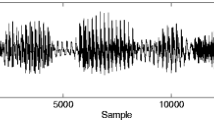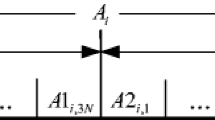Abstract
With the development of artificial intelligence and human-computer interaction, performance of man-machine voice dialogue system is becoming better and better. We proposed a new watermark detection method based on non-parametric model to mute machine voice when there are two or more robots around. We took a random sequence composed of 1 and − 1 as watermark in our experiment. In the embedding process, we modeled coefficients of speech frames after 3-level DWT (Discrete wavelet transform) though KDE (Kernel Density Estimation) of non-parametric test, and in watermark detection process, we designed a detector of ML (Maximum Likelihood), and calculated decision threshold by Neyman-Pearson criterion. We found proposed detector could respond when test speech signal was watermarked, and could further mute machine voice. We calculated the theoretical detection rates with false alarm rates from 0 to 1, and compared the theoretical values with experimental values. We found experimental values were very close to theoretical values, and they were almost close to 1 when false alarm rates were above 0.3. Compared with existing synthetic speech detection algorithms, our proposal was simpler and cost less, and was appropriate to detect watermark based on small samples. And our algorithm had a good imperceptibility and robustness, and average detection rates were all above 98% for some common noise attacks.













Similar content being viewed by others
Data availability
The datasets generated during and/or analysed during the current study are available from the corresponding author on reasonable request.
References
Abhijit P, Ramesh S (2022) Digital audio watermarking: techniques, applications, and challenges. Intell Sustain Syst 225:679–689
Akhaee MA, Sahraeian SME, Marvasti F (2010) Contourlet-based image watermarking using optimum detector in a noisy environment. IEEE Trans Image Process 19(4):967–980
Alaa F, Gamal A, Ayman ES, Marwa AS (2022) Copyright protection of deep neural network models using digital watermarking: a comparative study. Multimedia Tools and Applications 81:15961–15975
Alix L, Frederic C (2018) A sequential non-parametric multivariate two-sample test. IEEE Trans Inf Theory 64(5):3361–3371
Baharak A, Fatih K, Ahmed B (2018) Blind image watermark detection algorithm based on discrete shearlet transform using statistical decision theory. IEEE Trans Comput Imaging 4(1):46–59
Chen C, Han JQ (2020) TDMF: Task-driven multilevel framework for end-to-end speaker verification. In: 2020 IEEE International Conference on Acoustics, Speech and Signal Processing (ICASSP), 6809–6813
Ge J (2019) The self-embedding watermarking and its application in image tamper detection and recovery. In: Doctoral Dissertation of Central China Normal University
GitHub (2020) https://github.com/vBaiCai/python-pesq
Gunsel B, Ulker Y, Kirbiz S (2006) A statistical framework for audio watermark detection and decoding. In: Multimedia Content Representation, Classification and Security, 241–248
Hu HT, Hsu LY (2015) Robust, transparent and high-capacity audio watermarking in DCT domain. Signal Process 109:226–235
Kang XG, Yang R, Huang JW (2011) Geometric invariant audio watermarking based on an LCM feature. IEEE Trans Multimedia 13:181–190
Lei BY, Zhou F, Tan EL, Ni D, Lei HJ, Chen SP, Wang TF (2015) Optimal and secure audio watermarking scheme based on self-adaptive particle swarm optimization and quaternion wavelet transform. Signal Process 113:80–94
Liao J, Dong R, Li B, Chen QM (2014) A non-parametric motion model for foreground detection in camera jitter scenes. IEEE Signal Process Lett 21(6):677–681
Lin XD (2012) Watermark detection method in DCT domain based on gaussian mixture model. J Autom 38(9):1445–1448
Lv XL (2010) Research on robot sound source localization technology based on auditory information. In: Doctoral Dissertation of Hebei University of Technology
Marzieh A, Ahmad MO, Swamy MNS (2017) A new locally optimum watermark detector using vector-based hidden Markov model in wavelet domain. Signal Process 137:213–222
Michael A, Chen XM, Peter B, Ulrich G, Gwenael D (2014) A phase-based audio watermarking system robust to acoustic path propagation. IEEE Trans Inf Forensics Secur 9(3):411–425
Nematollahi MA, Al-Haddad SAR (2013) An overview of digital speech watermarking. Int J Speech Technol 16:471–488
Niu PP, Wang XY, Yang HY, Li L (2020) A blind watermark algorithm in SWT domain using bivariate generalized gaussian distributions. Multimedia Tools Appl 79:13351–13377
Sadegh E, Maryam A (2018) A new multiplicative watermark detector in the contourlet domain using t location-scale distribution. Pattern Recogn 77:99–112
Shuo L, Song ZJ, Lu WH, Wei JG (2017) Parameterization of LSB in self-recovery speech watermarking framework. Secur Commu Netw 3847092:1939–0114
Tang X (2015) Research on some key algorithms of audio digital watermarking. In: Doctoral Dissertation of Beijing University of Posts and Telecommunications
Wang TH, Florian K (2019) Attacks on digital watermarks for deep neural networks. In: 2019 IEEE International Conference on Acoustics, Speech and Signal Processing, 18778585, 2622–2626
Wang XY, Li L, Li HF, Niu PP, Wang SM, Yang HY (2017) A blind watermark decoder in DT CWT domain using multivariate Bessel K form distribution. Chin J Comput 40(182):1–16
Wang KX, Li C, Tian LH (2017) Audio zero watermarking for MP3 based on low frequency energy. In: The 6th International Conference on Informatics, Electronics and Vision & The 7th International Symposium in Computational Medical and Health Technology (ICIEV-ISCMHT), 1–5
Wansoo K, Kyogu L (2020) Digital watermarking for protecting audio classification datasets. In: 2020 IEEE International Conference on Acoustics, Speech and Signal Processing, 19788517, 2842–2846
Wu QL (2018) Research on robust audio digital watermarking scheme in transform domain. In: Doctoral Dissertation of Nanjing University of Posts and Telecommunications
Yang MH, Tao JH, Li H, Chao LL (2014) Natural multimodal human-computer-interaction dialog system. Comput Sci 41(10):12–18
Yang CS, Zhu CQ, Wang YY, Rui T, Zhu JW, Ding K (2020) A robust watermarking algorithm for vector geographic data based on QIM and matching detection. Multimedia Tools Appl 79:30709–30733
Yu H (2018) Spoofing speech detection research. In: Doctoral Dissertation of Beijing University of Posts and Telecommunications
Yu H, Tan ZH, Ma ZY, Martin R, Guo J (2018) Spoofing detection in automatic speaker verification systems using DNN classifiers and dynamic acoustic features. IEEE Trans Neural Netw Learn Syst 29(10):4633–4644
Yuan XC, Pun CM, Chen CL, Philip (2015) Robust mel-frequency cepstral coefficients feature detection and dual-tree complex wavelet transform for digital audio watermarking. Inform Sci 298:159–179
Zhang W, Wang DX, Yu L (2020) Fast echo cancellation algorithm in smart speaker. J Comput Appl 40(4):1191–1195
Zhang C (2014) A study on detection and recovery of speech signal tampering. In: Master’s Dissertation of Tianjin University
Zhong JD, Huang ST (2007) Double-sided watermark embedding and detection. IEEE Trans Inf Forensics Secur 2(3):297–310
Acknowledgements
This research was supported by the National Natural Science Foundation of China (No. NSFC61876131), and the Key Basic Research and Development of Ministry of Science and Technology (No.2018YFC0806802).
Author information
Authors and Affiliations
Corresponding author
Ethics declarations
Conflict of interest
We declare that we have no financial and personal relationships with other people or organizations that can inappropriately influence our work, there is no professional or other personal interest of any nature or kind in any product, service and/or company that could be construed as influencing the position presented in, or the review of the manuscript entitled “A Watermark Detection Scheme Based on Non-parametric Model Applied to Mute Machine Voice”.
Additional information
Publisher’s note
Springer Nature remains neutral with regard to jurisdictional claims in published maps and institutional affiliations.
Rights and permissions
Springer Nature or its licensor (e.g. a society or other partner) holds exclusive rights to this article under a publishing agreement with the author(s) or other rightsholder(s); author self-archiving of the accepted manuscript version of this article is solely governed by the terms of such publishing agreement and applicable law.
About this article
Cite this article
Hu, Y., Lu, W., Wei, J. et al. A watermark detection scheme based on non-parametric model applied to mute machine voice. Multimed Tools Appl 82, 44763–44782 (2023). https://doi.org/10.1007/s11042-023-15572-x
Received:
Revised:
Accepted:
Published:
Issue Date:
DOI: https://doi.org/10.1007/s11042-023-15572-x




